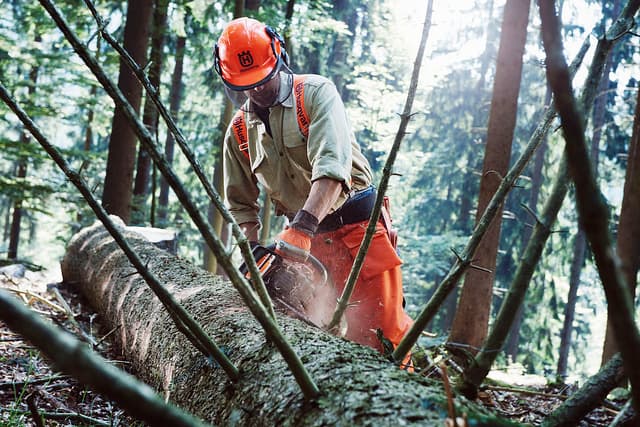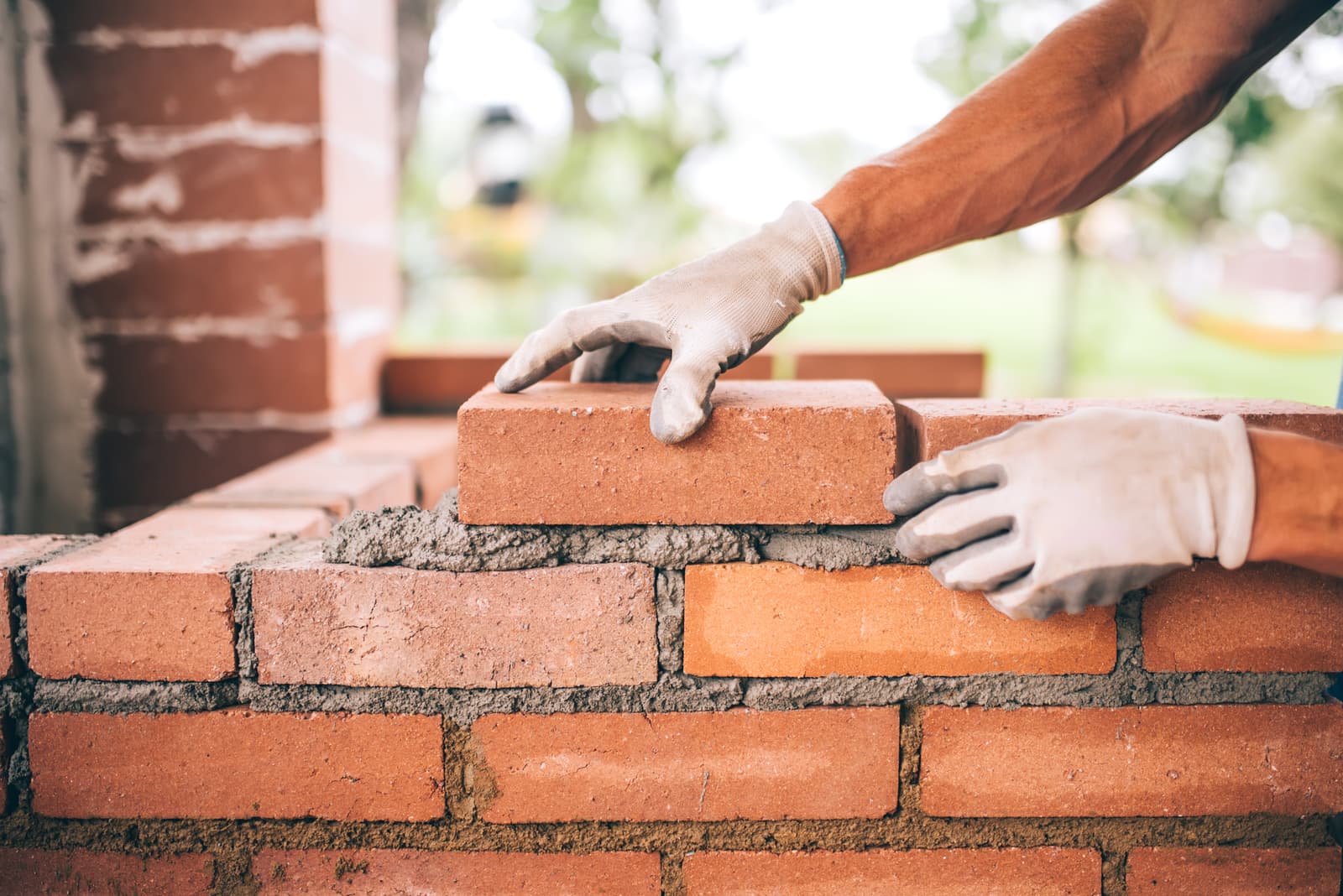How to Cut Down a Tree On Your Property
By Editorial Team
Updated on November 7, 2023

When watching old lumberjack documentaries, Canadians may get that feeling that felling trees is as much a part of their DNA as tapping maple trees during the sugaring-off season.
Think again! There’s a safe way to proceed to avoid any injuries, especially if you decide to cut down a tree on your property that’s near a roadway, pool, or kid’s play area. As such, it’s up to you to plan ahead!
What’s a safe felling plan?
According to the Commission des normes, de l’équité, de la santé et de la sécurité au travail (CNESST), it’s best to put together a safe felling plan. Naturally, these measures are intended for forestry workers who are tasked with cutting down trees, one after the other, with a chainsaw. However, these safety standards also apply to the general public when an individual decides to cut down a tree or hire a professional to do so, that way, they’ll be able to secure the area with full knowledge of the matter.
In Quebec, a safety felling plan can be summarized by the French acronym “DISEP,” which basically relates to the following: danger, inclination, safety route (escape path), the width of the hinge, and the felling plan.
The logger must be able to spot potential sources of danger: dead trees, hazardous trees, problematic stems, dead branches, hanging branches, embedded trees, some aspects like the slope of the terrain, obstacles found at ground level, and the direction of the felling.
Fellers will, to lessen the strain, look for things that could influence the tree’s fall: the tree’s natural angle and its curvature, wind force and direction, weight distribution in the crown area, freezing rain, and snow.
The worker will also have to spot two escape paths opposite the direction of the fall, roughly 45 degrees from where the tree is expected to fall. The area in front of where the tree is to drop is dangerous.
The feller will have to determine the width of the hinge required, which must equal 1/10 of the diameter of the tree’s trunk. The hinge refers to the section of the trunk located between the notch and felling cut, which will serve to control the tree’s fall and prevent any lateral motions, in other words, to prevent the tree from falling sideways. The hinge will “fold over” in the desired direction provided that the directional notch opening and the felling cut are well done.

Photo: Chechi Peinado
Based on this analysis, the feller can then establish a felling plan: The risks to eliminate, the direction in which the tree should fall, the felling method, the type of notch and felling cut that should be done, the tools to use, as well as the escape paths to employ.
What’s the safest way to cut down a tree?
Have the necessary personal protective gear: a tool belt, 20 cm lifting clamp, pressure dressing, tape measure, lifting hook, file with handle, 225 g of ABC dry chemical, a “Danger” cordon tape, tree felling lever, wedge, no-spill gas can, depth gauge, felling lever hook with a short and long handle.
Ensure that no one is standing in the felling zone, meaning within 45 m of the feller.
Prioritize cutting down dead trees, meaning tree stumps and leftover branches.
Clear the terrain surrounding the tree to be felled: Get rid of all potential hazards in the felling area, clear the foot of the tree and the escape paths, those the feller will use to move away from the falling tree.
Prune the base of the trunk while ensuring the tree and the chainsaw’s guide bar are kept in place.
Always hold the chainsaw lower than shoulder level.
Avoid cutting using the upper part of the guide bar to prevent the chainsaw from kicking back, which could be fatal.
Make a notch and felling cut. There are four different types of notch and felling cuts.
Use a felling level or a wedge when needed.
Move 2 m into the escape path during the tree’s fall.

Photo: All Eminov
How to Use a Chainsaw
Watching a professional feller at work, using a chainsaw, at first glance, handling such a tool may appear easy. However, operating it isn’t without risk of injuries, death, or fire.
To fill up the tank, the portable cans must be CSA B376-M1980 compliant and include WHMIS markings. To prevent a fire, start up the chainsaw at least 3 m away from where the gas tank was filled. Furthermore, smoking while filing up is prohibited and one must have a 225 g canister of ABC dry chemical powder on hand.
To start the chainsaw, the feller must hold down the chain break, place the saw on the ground while putting their left hand on the front handle while holding it firmly on the ground with their foot or knee or hold the rear handle between their knees and place their left hand on the front grip.
Moving around with a saw: Any worker walking with a chainsaw must take certain precautionary measures. They must activate the chain break as soon as they plan on moving further than the standard distance between two trees. They must also cut the power when heading to their work area.
What kind of notch cuts are there?
To cut down a tree, swinging an axe repeatedly in a tree trunk, in the same spot, until it keels over, won’t do. Also, merely tugging and pulling a saw on either side of the trunk with the help of a buddy, hoping it falls in between the two of you isn't going to cut it, pun intended.
Albeit equipped with a chainsaw, it’s still advised against, even dangerous, to proceed this way since it’ll be impossible to predict where the tree will fall. It could fall in the right direction like it could fall in your pool, on your house, or on you. It’s super important to make a “hinge” at the base of the trunk, which is basically made up of a notch and then a felling cut.

Photo: CIFOR
You can choose between four different types:
The conventional notch cut can be used on most trees with a sloping cut that’s at most 45 degrees with a 59-degree notch at most.
The V-shaped cut is used during winter, if the tree is on sloping ground or if it has a hole in the middle of its trunk, and the notch cut is between 60 and 100 degrees.
The open-faced notch is used during winter, if the tree is on a sloping ground or if it has a hole in the middle of its trunk, and the notch cut is between 80 and 100 degrees.
The Humboldt is used on trees with high-value wood, and the sloping cut is at least 45 degrees with a 59-degree notch at most.
Once the notch has been made, you simply have to cut the trunk in a straight (felling) line on the other side. The bottom cut is perpendicular to the trunk and must be level with the sloping (top) cut. Note that the Humboldt with a downward cut line is the complete opposite of the conventional notch cut with its upward-sloping cut, although they may appear similar.
How to Limb a Fallen Tree
Now that the tree is on the ground, you have to cut the branches. If their circumference is smaller than that of the trunk, thus easier to cut with a chainsaw, you must proceed carefully. The chainsaw can kick back and injure you. As such, it's best to use a limbing method that requires less effort and reduces the risk of injury, while adhering to the following safety rules:

Photo: canopic
Follow the following safety rules:
Position yourself in a stable way with bent knees instead of bending over.
Grasp the saw tightly, thumb on the front handle.
Run the saw at full speed.
Keep the chainsaw near your body.
Brace the chainsaw against the tree trunk to relieve the strain.
Avoid moving when sawing from the side of the log on which you’re standing.
Avoid obstacles that could cause the chainsaw to kick back.
Don't use the tip of the guide bar when tree limbing.
Don’t cut toward your body when using the upper-end section of the guide bar.
Lock the chain brake when you take your hand off the front handle.
Never step on the tree being limbed.
On a hillside, move to the highest point in relation to the tree to be limbed.
As for the method, start at the base of the trunk to remove all branches by moving the chainsaw blade downward while still putting pressure on the trunk, the section of the tree that’s on the ground. Clear the cut-off branches to avoid creating obstacles. Once the high branches have been cut, move on to the ones below to finally flip the trunk over to then cut the branches that were beneath it. This part of the process is quite time-consuming; you’ll have to exercise some patience.
What reasons are there to cut down a tree?
You may want to cut down a tree merely for aesthetic reasons because it's not something you want on your property. If a tree is interfering with an electric grid, hanging over your fence or looking unhealthy, it's probably beyond your control to remove it.
If a tree on your property appears to be touching the power lines at the top of utility poles, feel free to contact Hydro-Québec. This government agency employs trained arborists to perform work near power lines. The company will carry out the work for you.

Photo: John
If a tree on a neighbouring property has branches and roots hanging over or under your fence, you’re not allowed to cut them. You can, on the other hand, come to an understanding with your neighbour to have them cut. If they refuse, you can take the matter to court to show that the branches and/or roots seriously impede the proper use of your property.
If the tree is sick, a lot of options are available to you. The emerald ash borer isn’t a severe illness, it’s actually an insect from South-East Asia that has been wreaking havoc in the South West of Quebec since 2008, resulting in the felling of 10,000 of the 200,000 ash trees on the island of Montréal. In Saguenay, 400 trees are suffering from the Dutch elm disease. You can consult the tree disease directory (French only).
Cutting down a tree in the city…
According to the Ombudsman de Montréal, cutting down a tree in your metropolitan will solely be awarded if the tree is dead or suffering from an irreversible illness; if the tree is a public health and safety hazard; if the tree is causing or is likely to cause a public nuisance or serious property damage; if the tree is located on or near a construction work site. Also, if a tree belonging to the city appears to present a problem, it’s important to reach out to Accès Montréal so that a city inspector is dispatched to the area.
According to the City of Laval, it costs $75 per tree and the felling is authorized if the tree is dead or its condition is in a state of irreversible deterioration; if the tree is sick or insect-infested; if the tree presents as a public safety and property hazard making any arboricultural remedial work impossible; if the tree interferes with the construction or development of a structure in accordance with the issuance of a planning permit. Although a permit is required to cut down an ash tree, there's no fee. The City of Laval is currently required to cut down all trees situated within municipal rights-of-way.
According to the City of Québec, tree felling is monitored on private property and remains one of the most efficient ways to limit excessive tree cutting, however, it can be necessary to do so if the tree is dead, a hazard, wilting, or sick. When it comes to building a structure, garage, extension, or other, if you can get the required permits, you can cut down a tree for this reason.
Get 3 quotes for your tree-cutting/landscaping project
RenoQuotes.com can help you get quotes for your tree-cutting project. When submitting your project, we’ll put you in contact with top-rated contractors. Fill in the form on the homepage (it only takes a few minutes), and receive quotes from companies that are specialized in home renovations.
Dial 1-844 828-1588 to speak with one of our customer service representatives.
Looking for something else?
Related articles
The latest industry news, interviews, technologies, and resources.

Editorial Team
•19 Dec 2024
For those who live in cities, having a large backyard often proves challenging. Unless you come across the perfect spot, you may very well have to deal with a property that offers a small garden space.

Editorial Team
•30 May 2025
Building a patio is a great way to elevate your outdoor space, designing the ideal area to lounge, entertain guests, or simply enjoy the outdoors. Choosing your patio pavers isn’t just a stepping stone, but the initial step, impacting not only your patio’s aesthetics, but also its long-term durability and maintenance. Whether you’re looking for something natural, modern, or unique, this article will guide you through the essential criteria to consider when selecting the perfect pavers for your patio space.

Editorial Team
•10 Apr 2025
Finding an efficient heating solution is crucial when temperatures start dropping and the cold front is settling in our homes. Electric baseboard heaters have already won over 40% of all Quebec households, and there are plenty of reasons for such a heating system’s popularity.

Léa Plourde-Archer
•06 Jun 2025
Masonry and bricklaying are more than a skill, they are a craft. When it comes to the requirements for working with concrete and brick, you’ll need to work with a person who has specific training. These materials are especially difficult to manipulate, and thus, it’s almost always best to work with a professional. Of course, working with a mason or bricklayer will leave you with lifelong structures and pieces, adding to the individuality and resale value of your home.

Editorial Team
•07 Nov 2023
Quartz countertops are popular for kitchen remodelling projects, valued as much for their durability as they are for the pattern and colour variations in which they’re available.